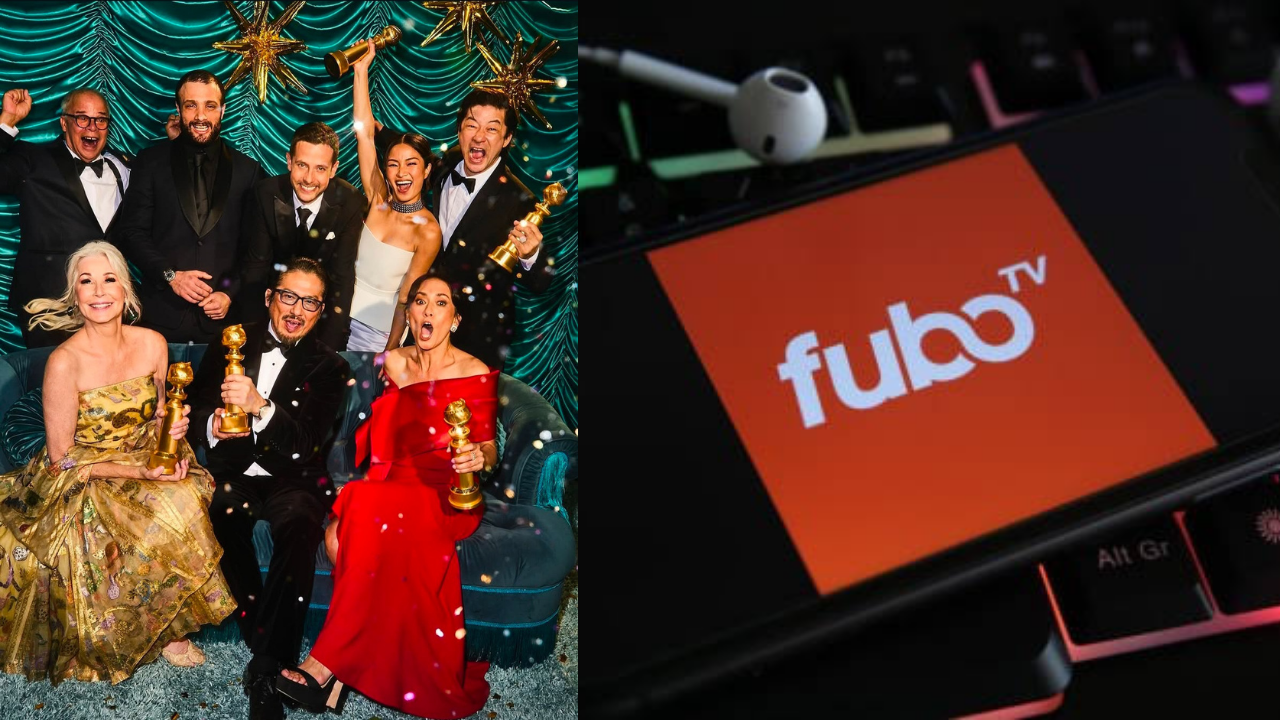Movies
The Nun 2: Did you know the actual history of Saint Lucy?

The story of The Nun 2 has the mention of the legend of St. Lucy and you might think that it’s a made-up thing about her but there are real mentions of her in Catholic orthodoxy. Scroll through the article to know more
As the conjuring franchise expands, people will continue to get an amazing lineup of movies. While most of the horror movies these days are made up around fictional stories and experiences, the Conjuring franchise has been built and marketed upon the pitch that these stories are based on true events. Particularly, the first movies directed by James Wan were believed to be inspired by the cases experienced by Paranormal activity investigators, Ed and Lorraine. In Fact Talking about the recent addition to the franchise, The Nun 2 is based on the demon Nun who is on the run to search for the eyes of St. Lucy. And viewers might think that the legend of St. Lucy is a made-up thing for the film but it is real, in the Catholic Canon and Orthodoxy.

The actual history VS the film
In the film, Sister Irene asked the Priest/Librarian in the Vatican about St. Lucy of Syracuse and why the demon Valak is after her eyes? The film emphasized on the fact that the eyes of St. Lucy held immense power and that’s why the demon went after it. The priest tells Sister Irene that St. Lucy was killed by the pagans and while she died, her family escaped and was scattered across Europe. The film goes on in implying that Sister Irene and even Lorraine Warren are the descendants of St. Lucy, a fact that is kind of hard to digest as she is worshiped in the Catholic Church as a virgin martyr and there are no records or mentions of her having siblings.

There is a lot of debate around the actual story of St. Lucy as some scholars say that the whole thing was created by the early Catholic Church. The first written accounts about her mention come from the fish ventures in Acts of the Martyrs which was about a hundred years after her death. According to various archaeological evidences, there was a cult who worshiped Lucia of Syracuse in Sicily during the fourth century and it is also believed that the body parts of her were indeed, scattered across Europe. According to the famous legend, Lucia of Syracuse was born in 283 A.D., had a Roman and Greek Heritage and she was a part of the Roman Empire. She is known to be the earliest non-clergy or non-military Martyrs as she was killed for her unwavering religious faith during the Diocletianic Persecution. At that time, Christianity already stood on a shaky ground and many believers were killed by mobs. The historical mention of Lucia comes into focus around 304 A.D according to which her mother had betrothed her to a rich young suitor whose family kept the pagan gods of Jupiter and the empire without caring about her daughter’s wishes on this matter. Later, they both went to a pilgrimage together in Catania where they visited the site of St. Agatha’s Martyrdom who was murdered during the great persecution of Cristians by the Roman State.

Lucia asks her mother to donate her diary to the poor and needy instead of saving for her marriage. The news of this act of charity reached the betrothed and he was definitely outraged by the loss and thus, he denounced Lucia as a Cristian to Paschasius, the Governor of Syracuse. The Roman government demanded Lucia to be burnt alive as a sacrifice in the honor of Emperor Diocletian’s image and divinity. When asked to apostatize her faith. Lucia refused. As per the Catholic beliefs, Paschasius ordered Lucia to be condemned to a brothel where she would spend the rest of her life but when the guards attempted to force Lusics out of her home, her feet didn’t move. Not even when they tried it with full force. In this case, they turned to burn her alive but that didn’t work either as the flames did no harm to her. Finally, a soldier stabbed Lucia in the throat which took her life. But what about her eyes? It is believed that the gathering crowd was sympathizing too much with the beautiful young girl during the prosecution. And thus, the Roman Governor Paschasius ordered her eyes to be gouged out.
Also Read – FLCL: Grunge Review – Does the new sequel live up to expectations?
Follow Us – Dis_cultured
Business
France’s Reckoning With Ultra-Fast Fashion: Why Shein Is at the Center of a Larger Conversation?

There appears to be a quiet yet undeniable shift underway in how nations are beginning to reckon with the fashion industry, particularly the segment that thrives on speed, relentless volume, and the seductive promise of impossibly low prices. In 2025, France has emerged as one of the first major economies to confront this hyper-accelerated model head-on, not merely by issuing fines or launching investigations, but by challenging the very system that enables it. At the center of this reckoning stands Shein, the Chinese retail juggernaut that has become synonymous with algorithm-driven production. Yet, what makes this moment in France especially significant is not only the legal action being taken against a single company, it is the broader cultural and ethical inquiry being posed. With growing urgency, the country seems to be asking whether we can continue to dress ourselves at this breakneck pace, cloaked in convenience and novelty, without confronting the environmental, human, and psychological costs that are too often obscured by polished interfaces.
€40 Million Fine for Misleading Practices
In July 2025, France’s Directorate General for Competition, Consumer Affairs and Fraud Control (DGCCRF), the country’s principal consumer protection authority, levied a €40 million fine against Shein, marking one of the most high-profile regulatory actions yet against a fast fashion giant. The fine followed an extensive investigation conducted between October 2022 and August 2023, which uncovered a pattern of misleading business practices at the centre of Shein’s digital storefront. More than half of the discounts promoted on its website were found to be deceptive, offering no tangible benefit to the consumer, while others relied on inflated original prices to manufacture the illusion of savings. Even more concerning to regulators were the company’s sustainability claims: bold assurances of a 25% reduction in greenhouse gas emissions and microfiber pollution were, as the DGCCRF concluded, entirely unsubstantiated and unsupported by verifiable data. Though Shein, through its European subsidiary Infinite Style Ecommerce Co Ltd (ISEL), accepted the penalty and claimed to have implemented corrective measures by May 2023, the underlying message from French authorities rang louder than any corporate statement.

Proposed Legislation Signals a Larger Shift
While the €40 million fine made headlines, it represents just one facet of the mounting scrutiny Shein now faces in France. In June 2025, the French Senate took a more structural approach by passing a groundbreaking bill that, if enacted, could fundamentally alter the way ultra-fast fashion brands operate within the country. At the centre of this proposed legislation is an eco-contribution tax. The bill also lays out stringent new requirements for sustainability reporting, alongside tough advertising regulations that aim to limit visibility for brands that fail to meet clear environmental standards. One of the most notable implications of the legislation lies in its potential to curtail influencer-led marketing strategies, a pillar of customer acquisition for companies like Shein that rely heavily on social media virality and affiliate promotions. Although advocacy groups have raised concerns about a perceived disparity in how European retailers, including Zara and H&M, are being treated under the same regulatory lens, the passage of this bill signals something deeper. It reflects a growing legislative will to confront not just the ecological toll of ultra-fast fashion, but also its broader cultural, ethical, and economic footprint, raising the question of whether the era of unchecked consumerism is nearing its limits.
The Environmental Impact Can’t Be Ignored
One of the driving forces behind the intensified scrutiny Shein now faces lies in the sheer scale of its environmental impact, an impact that reflects not only the brand’s rapid growth but also the systemic problems embedded within the ultra-fast fashion model. The fashion industry as a whole is already responsible for an estimated 10 percent of global carbon emissions, and Shein’s contribution to that figure is anything but marginal. In parallel, French authorities have flagged more than 700 Shein products for failing to adequately disclose environmental risks, particularly those related to microfiber pollution which is an increasingly urgent concern as microplastics continue to infiltrate aquatic ecosystems and public water systems. Beyond environmental violations, the company also remains entangled in serious allegations of labor abuses, including reported connections to forced labor in China’s Xinjiang region, which have only amplified the demand for a more enforceable supply chain transparency. Taken together, these issues have not only galvanized French regulators but are also prompting broader conversations across the European Union about whether the time has come to rein in the unchecked dominance of platforms that have long operated at the intersection of convenience, opacity, and cost-cutting excess.
EU Expands Regulatory Focus on Digital Fashion Platforms
The regulatory pressure mounting against Shein is no longer confined to France alone. The company is now being closely scrutinized at the European level, where its practices are being examined under the framework of the European Union’s Digital Services Act (DSA). In July, French Trade Minister Véronique Louwagie confirmed that formal investigations had been initiated to determine whether Shein is deploying so-called “dark patterns”. These tactics, while not always illegal, are increasingly seen as ethically questionable, especially when used at the scale and speed that Shein commands. The European Commission has already expressed concern over misleading pricing strategies and a general lack of transparency in the platform’s operations, signaling that the company may soon face regulatory consequences that extend well beyond French jurisdiction. What initially began as a case rooted in consumer rights has turned into a far-reaching conversation about digital ethics, platform accountability, and the environmental consequences of unchecked e-commerce, placing Shein at the center of a growing movement to hold digital-first fashion retailers to a higher standard of responsibility.
The Reaction: Divided but Loud
The public reaction to France’s regulatory moves against Shein has been swift, impassioned, and divided, reflecting the complexity of the issues at hand. Many people have welcomed the measures as a long-overdue reckoning for a fashion industry that has long operated in the shadows of overproduction, exploitative labor practices, and environmentally damaging shortcuts. For these voices, the crackdown represents a necessary step toward holding global retailers accountable for the true cost of low-cost fashion. Yet, not everyone sees it that way. Critics of the legislation have expressed concern that such regulations could disproportionately affect low-income consumers, many of whom turn to platforms like Shein for affordable access to clothing and personal expression. Through this lens, Shein can attempt to shift the conversation toward themes of economic inclusion and consumer freedom, portraying itself as a platform that democratizes fashion rather than undermines it. At its core, the debate is about far more than a single company. It is a larger tug-of-war between the urgent need for accountability and the equally pressing question of affordability.
Why This Matters
France’s actions in 2025 are not merely a response to the conduct of a single company but represent a deeper interrogation of the values, compromises, and contradictions that lie at the heart of the global fashion industry. When a country with as much cultural and political influence as France begins to layer financial penalties, proposed eco-taxes, advertising restrictions, and cross-border regulatory cooperation into a cohesive strategy, it signals more than just regulatory intent. It marks the beginning of a broader shift in how we understand fashion’s role in society. The question now is whether brands like Shein will evolve in response to this changing situation or attempt to maintain their dominance through speed, affordability, and mass appeal alone. Just as importantly, it remains to be seen how consumers will react when asked to look beyond the immediate gratification of the checkout page and confront the realities of where, how, and at what cost their garments are made. France may not bring the era of ultra-fast fashion to a halt overnight. But it may well be laying the groundwork for something more enduring.
Also Read: Your Wardrobe Might Be Reflecting a Recession
Follow us for more : Dis_cultured
Events
The Most Memorable Highlights from the 2025 Academy Awards

Surprises, Stunning Wins, and Emotional Tributes – The 2025 Oscars Had It All. Catch Up with All the Highlights.
The 2025 Academy Awards, held on March 2 at the Dolby Theatre in Hollywood, was a night of triumphs and surprises that had the attention of audiences worldwide. Hosted by Conan O’Brien, the event was lively, full of humor, and celebrated the diversity and creativity of cinema from all around the world. This year’s ceremony stood out for its focus on inclusivity and representation, highlighting the growing diversity and global reach of the film industry. It was also about recognizing talent and stories from across the globe, signaling a shift in how the Academy values the changing trends in filmmaking.
Historic Wins for Anora

The evening’s biggest winner was undoubtedly Anora, an indie film that took home five Oscars, including the coveted Best Picture. Sean Baker’s direction was celebrated with a Best Director win, making him only the second person in history to win four individual Oscars in a single night, joining the ranks of Walt Disney. But the film’s success didn’t end there—Mikey Madison, portraying a sex worker entangled with a Russian oligarch’s son, secured Best Actress. At just 25, Madison made history as the ninth youngest actress to win the prestigious award. The triumph of Anora was a testament to its sweeping storytelling, captivating performances, and fresh perspective in filmmaking.
Zoë Saldaña and Paul Tazewell Breaking Barriers
The night also saw a series of groundbreaking wins that reflected Hollywood’s ongoing push for inclusivity and diversity. Zoë Saldaña made history as the first American of Dominican descent to win Best Supporting Actress for her role in Emilia Pérez. Saldaña’s win was not only a recognition of her immense talent but also an important milestone for the representation of marginalized voices in the film industry.
Meanwhile, Paul Tazewell took home Best Costume Design for his work on Wicked. Tazewell became the first Black man to ever win in this category, making a significant mark on the history of the Academy Awards.
Adrien Brody’s Second Oscar Win

Another highlight of the evening was Adrien Brody, who secured Best Actor for his performance in The Brutalist. Brody’s win, marking his second Oscar, was well-deserved after delivering a deeply compelling and nuanced performance. His emotional portrayal in the film left a lasting impact on both critics and audiences, making his victory one of the night’s most celebrated moments in the acting categories.
A Heartfelt Musical Tribute by Ariana Grande and Cynthia Erivo

The musical performances were another standout feature of the night. Ariana Grande and Cynthia Erivo took the stage for a touching tribute to Los Angeles, which was recovering from the devastating wildfires. Their renditions of Somewhere Over the Rainbow and Defying Gravity left the audience in awe, showcasing the emotional power of music and its ability to unite and heal. It was a heartfelt moment that reminded everyone of the strength of the city and the spirit of resilience.
Adam Sandler’s Quirky Fashion Moment

In true Oscar tradition, the night wasn’t without its lighthearted moments. Adam Sandler became the talk of social media when he showed up to the ceremony in gym shorts. Conan O’Brien couldn’t resist poking fun at Sandler’s unconventional choice, adding humor to the event. The quirky fashion moment quickly became a viral topic, sparking discussions about casual red carpet looks and how even the most unexpected outfits can become part of the Oscar narrative.
Controversies and Unexpected Upsets
Not everything went smoothly, though. The night also saw some controversies that added an extra layer of drama to the proceedings. One of the most talked-about moments occurred when Iranian co-director Hossein Molayemi interrupted his partner, Shirin Sohani, during their acceptance speech for Best Animated Short Film for In the Shadow of the Cypress. Molayemi’s actions were met with backlash on social media, with many criticizing him for overshadowing Sohani’s moment. The ceremony also saw a surprising upset in the Best Actress category when Demi Moore, who was widely favored to win for her role in The Substance, lost out to Mikey Madison. This unexpected loss left many questioning the voting choices and added to the evening’s fair share of shocking moments.
Despite the controversies, the 2025 Oscars will undoubtedly be remembered as a night that reflected both the changing tides of the industry and the enduring power of film.
Also Read: Weekly Pop Culture Recap: Microsoft to discontinue Skype by May, Best Highlights from the Milan Fashion Week
Follow us for more @Discultured
Events
Weekly Pop Culture Recap: Talkworthy Highlights from the 82nd Golden Globes Awards, Disney’s Merger with FuboTV and Much More

Read on as we break down the biggest pop culture moments you don’t want to miss.
Pop culture has a way of keeping us on our toes, doesn’t it? Every week, there’s something new to talk about—whether it’s a jaw-dropping red-carpet moment, a groundbreaking announcement, or just a story that makes you stop and think. It’s what keeps our group chats buzzing and our feeds endlessly scrollable. Read on as we unpack the most buzzworthy highlights of the week.
The 82nd Golden Globe Awards
The 82nd Golden Globe Awards, held on January 5, 2025, at The Beverly Hilton in Los Angeles, was a night to remember, hosted by Nikki Glaser. One of the most significant moments of the night was Karla Sofía Gascón, who made history as the first trans nominee in a Golden Globe 2025 Screen Actors Guild Awards in a solo category. She was nominated for Best Actress in a leading role for her role in Emilia Pérez.
Another highlight came from Demi Moore, who won Best Actress in a Motion Picture for her role in The Substance. During her speech, she shared a personal story about a time in her career when a producer told her she was just a “popcorn actress,” which made her doubt herself. Despite facing those challenges, she found new inspiration through The Substance, describing the script as “magical” and “bold.” It was a powerful and emotional moment for Demi, marking a triumphant return to the spotlight.
Seems like the peplum style, popular in the 2010s, is also making a return. Celebrities like Rihanna, Harry Styles, Florence Pugh, and Kate Middleton have been spotted wearing peplum designs. At the 82nd Golden Globes, stars such as Cynthia Erivo and Anna Sawai showcased this trend, signaling its resurgence. While some millennials express mixed feelings about its return, others appreciate its flattering effect on various body types.
Family Guy” Returns to Adult Swim:
After a hiatus, “Family Guy” reruns have returned to Adult Swim for the first time since 2021. This follows a non-exclusive deal for the rights to older episodes, bringing the beloved animated series back to its original late-night home.
Disney and FuboTV Merger:
Disney has agreed to merge Hulu + Live TV with FuboTV, aiming to enhance their streaming offerings. This merger is expected to provide subscribers with a more comprehensive and diverse range of content, consolidating their streaming services under one umbrella.
The Tamil film, “Maharaja” Gains Unexpected Popularity in China
Mahraja, starring Vijay Sethupathi, has unexpectedly become a hit in China. The Tamil film’s emotional storyline, centered around a father-daughter relationship, has resonated with Chinese audiences. Its success marks a rare achievement for a South Indian film in the international market, showcasing the global appeal of its narrative and Vijay Sethupathi’s performance.
Also Read: Emerging Fashion Designers India Contest Season 2 Put Budding Talent in the Spotlight
Follow us for more – @Dis_cultured
-

 Beauty9 months ago
Beauty9 months agoKaftans: The New Festive Staple Taking Over Indian Wardrobes
-

 Events4 months ago
Events4 months agoThe Most Memorable Highlights from the 2025 Academy Awards
-

 Fashion8 months ago
Fashion8 months agoThe NOU Walk Of Life : New Talk of Town in Luxury Footwear
-

 Events11 months ago
Events11 months agoRevisiting some of the Most Iconic Moments in the History of the Olympics!
-

 Pop Culture9 months ago
Pop Culture9 months agoWhy We Need Representation in Toys: The Case for Diwali Barbie and Beyond
-

 Fashion3 months ago
Fashion3 months agoYour Wardrobe Might Be Reflecting a Recession
-

 Events8 months ago
Events8 months agoDorsia, Gurgaon’s One Of The Biggest BYOBs
-

 Events6 months ago
Events6 months agoWeekly Pop Culture Recap: Talkworthy Highlights from the 82nd Golden Globes Awards, Disney’s Merger with FuboTV and Much More










